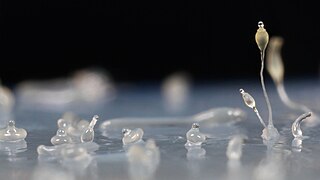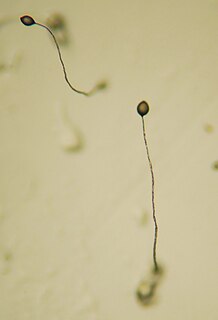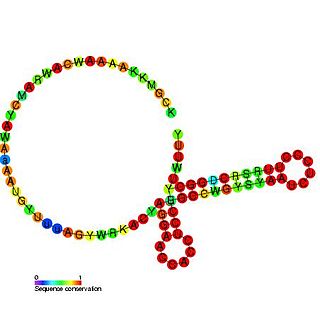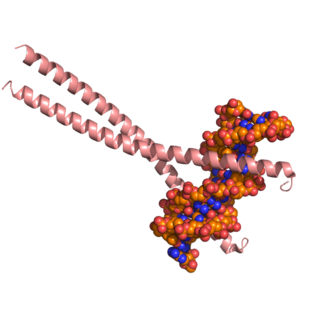Related Research Articles

Cyclic adenosine monophosphate is a second messenger important in many biological processes. cAMP is a derivative of adenosine triphosphate (ATP) and used for intracellular signal transduction in many different organisms, conveying the cAMP-dependent pathway. It should not be confused with 5'-AMP-activated protein kinase.

The dictyostelids are a group of cellular slime molds, or social amoebae.

Dictyostelium is a genus of single- and multi-celled eukaryotic, phagotrophic bacterivores. Though they are Protista and in no way fungal, they traditionally are known as "slime molds". They are present in most terrestrial ecosystems as a normal and often abundant component of the soil microflora, and play an important role in the maintenance of balanced bacterial populations in soils.

The CyaR RNA non-coding RNA was identified in a large scale screen of Escherichia coli and was called candidate 14. The exact 5′ and 3′ ends of this RNA are uncertain. This gene lies between yegQ and orgK in E. coli. This small RNA was shown to be bound by the Hfq protein. This RNA has been renamed as CyaR for. It has been shown that the CyaR RNA acts as a repressor of the porin OmpX. It has also been shown that cyaR expression is tightly controlled by the cyclic AMP receptor protein, CRP.

CCAAT/enhancer-binding protein beta is a protein that in humans is encoded by the CEBPB gene.

Transcription factor E2F4 is a protein that in humans is encoded by the E2F4 gene.

Low molecular weight phosphotyrosine protein phosphatase is an enzyme that in humans is encoded by the ACP1 gene.

Transcription factor E2F2 is a protein that in humans is encoded by the E2F2 gene.

G protein-coupled receptor 6, also known as GPR6, is a protein which in humans is encoded by the GPR6 gene.

Ephrin type-B receptor 1 is a protein that in humans is encoded by the EPHB1 gene.

Transcription factor Dp-1 is a protein that in humans is encoded by the TFDP1 gene.

Cyclic AMP-responsive element-binding protein 3 is a protein that in humans is encoded by the CREB3 gene.

Protein UXT also known as androgen receptor trapped clone 27 (ART-27) protein is a protein that in humans is encoded by the UXT gene.

cAMP-dependent protein kinase catalytic subunit gamma is an enzyme that in humans is encoded by the PRKACG gene.

Transcription factor TFIIIB component B″ homolog also known as TFIIIB150 is a protein that in humans is encoded by the BDP1 gene.

Secretoglobin family 3A member 2 is a protein that in humans is encoded by the SCGB3A2 gene.

Adenylyl cyclase type 4 is an enzyme that in humans is encoded by the ADCY4 gene.

Dictyostelium discoideum is a species of soil-dwelling amoeba belonging to the phylum Amoebozoa, infraphylum Mycetozoa. Commonly referred to as slime mold, D. discoideum is a eukaryote that transitions from a collection of unicellular amoebae into a multicellular slug and then into a fruiting body within its lifetime. Its unique asexual lifecycle consists of four stages: vegetative, aggregation, migration, and culmination. The lifecycle of D. discoideum is relatively short, which allows for timely viewing of all stages. The cells involved in the lifecycle undergo movement, chemical signaling, and development, which are applicable to human cancer research. The simplicity of its lifecycle makes D. discoideum a valuable model organism to study genetic, cellular, and biochemical processes in other organisms.
Chemorepulsion is the directional movement of a cell away from a substance. Of the two directional varieties of chemotaxis, chemoattraction has been studied to a much greater extent. Only recently have the key components of the chemorepulsive pathway been elucidated. The exact mechanism is still being investigated, and its constituents are currently being explored as likely candidates for immunotherapies.
In molecular biology mir-84 microRNA is a short RNA molecule. MicroRNAs function to regulate the expression levels of other genes by several mechanisms.
References
- ↑ Devreotes PN, Kimmel AR, Johnson RL, Klein PS, Sun TJ, Saxe III CL (1988). "A chemoattractant receptor controls development in Dictyostelium discoideum". Science. 241 (4872): 1467–1472. Bibcode:1988Sci...241.1467K. doi:10.1126/science.3047871. PMID 3047871.
- ↑ Ginsburg GT, Louis JM, Johnson R, Devreotes PN, Kimmel AR, Saxe III CL (1993). "CAR2, a prestalk cAMP receptor required for normal tip formation and late development of Dictyostelium discoideum". Genes Dev. 7 (2): 262–272. doi: 10.1101/gad.7.2.262 . PMID 8436297.
- ↑ Devreotes PN, Kimmel AR, Johnson RL, Gollop R, Saxe III CL (1993). "Identification and targeted gene disruption of cAR3, a cAMP receptor subtype expressed during multicellular stages of Dictyostelium development". Genes Dev. 7 (2): 273–282. doi: 10.1101/gad.7.2.273 . PMID 8382181.